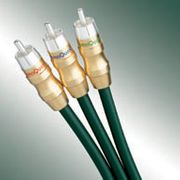AudioQuest YIQ2 - 7M
Product Description
Component video is the somewhat confusing name
for a three wire system which carries the "Y", "I" and
"Q" signals. Slightly confusing because the components of a color
signal are RGB (see next paragraph). "Y" is that same B & W signal
as in Y/C cable. "I" and "Q" are the components (get it?) of
a "C" signal. In order to derive three colors from a B & W signal,
there need to be two color difference signals, I = blue minus Y (add Y and get
blue), Q = red minus Y (add Y and get red), and once you have blue and red and Y
you can derive green. These three signals need exactly the same care and respect
as a composite video signal. Since standard YIQ connections are either RCA or
BNC, you can simply use three identical composite video cables, or for
convenience use a YIQ cable which has the three joined together. Don't get
fooled by some hype about specially designed for component video, either it's a
proper video cable or it isn't. When a piece of equipment sources from a YIQ
signal, such as DSS and DVD, using a YIQ cable setup will provide superior
performance over composite or "S".
AudioQuest YIQ-2 uses the same extremely
effective design as AudioQuest YIQ-1. The clearer, sharper picture is due to the
silver plated shield, which provides superior shielding and lower distortion.
All three AudioQuest Y cables have four times as large a conductor as an average
Y cable. Lengths should still be kept to a minimum, but CQ-Y cables can be run
in much longer lengths than other Y cables.

